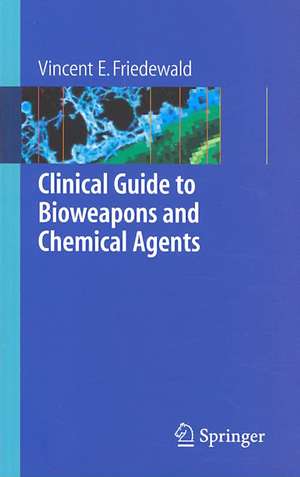Clinical Guide to Bioweapons and Chemical Agents
Autor Vincent Friedewalden Limba Engleză Paperback – 6 mai 2008
Preț: 373.33 lei
Preț vechi: 392.97 lei
-5% Nou
Puncte Express: 560
Preț estimativ în valută:
71.43€ • 74.79$ • 59.11£
71.43€ • 74.79$ • 59.11£
Carte tipărită la comandă
Livrare economică 05-19 aprilie
Preluare comenzi: 021 569.72.76
Specificații
ISBN-13: 9781846282553
ISBN-10: 1846282551
Pagini: 498
Ilustrații: XXXVIII, 498 p. 40 illus.
Dimensiuni: 127 x 203 x 24 mm
Greutate: 0.53 kg
Ediția:2008
Editura: SPRINGER LONDON
Colecția Springer
Locul publicării:London, United Kingdom
ISBN-10: 1846282551
Pagini: 498
Ilustrații: XXXVIII, 498 p. 40 illus.
Dimensiuni: 127 x 203 x 24 mm
Greutate: 0.53 kg
Ediția:2008
Editura: SPRINGER LONDON
Colecția Springer
Locul publicării:London, United Kingdom
Public țintă
Professional/practitionerDescriere
Recent events of the past 5 years are fundamentally driving the need for enhanced public health protection across the world. Although the issues are complex, one aspect is paramount: new, innovative approaches for early identification and intervention are essential for optimal responses to these dangers.
The many challenges confronting healthcare systems include:
With time in front of the patient always at a premium, there is the need for tools to aid the clinician in the efficient management of patients. While the majority of specialist clinicians have the complete diagnostic toolkit, many of the more unusual disorders and their diagnostic features are less clear to the general internist and primary care/family medicine physician.
It is with this in mind that the author has been collating the current diagnostic criteria for all health-related bioterrorist threats and other public health disorders. This book proposal represents the print version of this project and is intended to be a quick reference for the busy clinician. With this in mind, the format of the book will be designed for maximum ease of use in the clinic. It will have a pocketbook trim size and will extend to approximately 300 pages.
Although no single approach answers all of the challenges confronting our public health system, the book fulfills many of the requirements by providing:
The many challenges confronting healthcare systems include:
- Operation at near-capacity much of the time, with severely limited ability to absorb the increasing burdens of potential public health issues
- Serious neglect of the public health system for many years
- Suboptimal working relationships between public health agencies and "front-line" health care practitioners
With time in front of the patient always at a premium, there is the need for tools to aid the clinician in the efficient management of patients. While the majority of specialist clinicians have the complete diagnostic toolkit, many of the more unusual disorders and their diagnostic features are less clear to the general internist and primary care/family medicine physician.
It is with this in mind that the author has been collating the current diagnostic criteria for all health-related bioterrorist threats and other public health disorders. This book proposal represents the print version of this project and is intended to be a quick reference for the busy clinician. With this in mind, the format of the book will be designed for maximum ease of use in the clinic. It will have a pocketbook trim size and will extend to approximately 300 pages.
Although no single approach answers all of the challenges confronting our public health system, the book fulfills many of the requirements by providing:
- Point-of-care decision support for physicians, other health care workers, and first responders when confronted with suspected public health diseases and conditions;
- A common format and lexicon for all persons and entities involved in public health decisions and for ease of real-time data collection; and
- A means for mass education of health care professionals and first responders about specific diseases and conditions.
Cuprins
Clinical Guide—Infections.- Anthrax.- Avian Influenza.- Bolivian Hemorrhagic Fever.- Botulism.- Brucellosis.- Campylobacteriosis.- Chickenpox.- Cholera.- Clostridium Perfringens Gastroenteritis.- Crimean – Congo Hemorrhagic Fever.- Cryptosporidiosis.- Dengue.- E Coli 0157:h7.- Eastern Equine Encephalitis.- Ebola Hemorrhagic Fever.- Epsilon Toxin – Clostridia Perfringens.- Giardiasis.- Glanders.- Hantavirus Pulmonary Syndrome.- Hemorrhagic Fever with Renal Syndrome.- Infectious Hepatitis – Acute.- Infectious Mononucleosis.- Influenza.- Lassa Fever.- Legionellosis.- Leptospirosis.- Listeriosis.- Lyme Disease.- Lymphocytic Choriomeningitis.- Malaria.- Marburg Hemorrhagic Fever.- Melioidosis.- Meningococcemia.- Monkeypox.- Mumps.- OMSK Hemorrhagic Fever.- Parvovirus B19.- Plague.- Psittacosis.- Q Fever.- Rift Valley Fever.- Rocky Mountain Spotted Fever.- Rubella – Acquired.- Rubeola.- Salmonellosis.- SARS.- Shigellosis.- Smallpox.- Staphylococcus Food Poisoning.- Streptococcal Pharyngitis.- Trichinellosis.- Tularemia.- Typhoid Fever.- Typhus – Epidemic.- Typhus – Murine.- Typhus – Scrub.- Venezuelan Equine Encephalitis.- Viral Gastroenteritis.- Viral Rhinitis.- West Nile Fever.- Western Equine Encephalitis.- Yellow Fever.- Yersiniosis.- Clinical Guide—Poisons.- Ammonia Poisoning.- Arsenic Poisoning.- Arsine Poisoning.- Barium Poisoning.- Benzene Poisoning.- Brevetoxin Poisoning.- Bromine Poisoning.- BZ Poisoning.- Carbon Monoxide Poisoning.- Chlorine Poisoning.- Colchicine Poisoning.- Cyanide Poisoning.- Digitalis Poisoning.- Elemental Mercury Poisoning—Acute.- Ethylene Glycol Poisoning.- Lewisite Poisoning.- Methyl Bromide Poisoning.- Methyl Isocyanate Poisoning.- Nicotine Poisoning.- Opioid Poisoning.- Organophosphate Poisoning.- Osmium Tetroxide Poisoning.- Phosgene Poisoning.- Phosphine Poisoning.- Radiation Poisoning.- Ricin Poisoning.- Riot Control Agents Poisoning.- Sarin Poisoning.- Sodium Monofluoroacetate Poisoning.- Sulfuryl Fluoride Poisoning.- Sulfur Mustard Poisoning.- Super Warfarin Poisoning.- Tabun Poisoning.- Tetrodotoxin Poisoning.- Thallium Poisoning.- Trichothecene Poisoning.- VX Poisoning.- Clinical Guide—Acute Complications.- Adrenal Failure.- Arthritis.- Congestive Heart Failure.- Corneal Injury.- Dehydration.- Disseminated Intravascular Coagulation.- Guillain – Barré Syndrome.- Hemolytic Anemia.- Hepatic Failure.- Hyperkalemia.- Meningitis/Encephalitis.- Myocarditis.- Noncardiac Pulmonary Edema.- Orchitis.- Osteomyelitis.- Pancreatitis.- Pericarditis.- Pneumonia.- Renal Failure.- Respiratory Failure.- Rhabdomyolysis.- Thrombocytopenia.
Textul de pe ultima copertă
Terrorist events of the past few years are fundamentally driving the need for enhanced public health protection across the world. Although the issues are complex, one aspect is paramount: new, innovative approaches for early identification and intervention are essential for optimal responses to these dangers.
Clinical Guide to Bioweapons and Chemical Agents is a quick reference for the busy clinician, to assist in the new public health response to the threats from bioterrorism and other public health disease.
Although no single approach answers all of the challenges confronting our public health system, the book fulfills many of the requirements by providing point-of-care decision support for physicians, other health care workers, and first responders when confronted with suspected public health diseases and conditions. Using a simple format and lexicon the book is designed for ease of real-time data collection and as a means for mass education of health care professionals and first responders about specific diseases and conditions. It combines established principles of disease management protocols with effective differential diagnosis algorithms.
The Clinical Guide is written for physicians, emergency medical responders, and other health care professionals for use at the front line, in the Emergency Department, and in the clinic as a first responder’s tool of choice.
Clinical Guide to Bioweapons and Chemical Agents is a quick reference for the busy clinician, to assist in the new public health response to the threats from bioterrorism and other public health disease.
Although no single approach answers all of the challenges confronting our public health system, the book fulfills many of the requirements by providing point-of-care decision support for physicians, other health care workers, and first responders when confronted with suspected public health diseases and conditions. Using a simple format and lexicon the book is designed for ease of real-time data collection and as a means for mass education of health care professionals and first responders about specific diseases and conditions. It combines established principles of disease management protocols with effective differential diagnosis algorithms.
The Clinical Guide is written for physicians, emergency medical responders, and other health care professionals for use at the front line, in the Emergency Department, and in the clinic as a first responder’s tool of choice.
Caracteristici
Point-of-care decision support for physicians, other health care workers, and first responders when confronted with suspected public health diseases and conditions
A common format and lexicon for all persons and entities involved in public health decisions and for ease of real-time data collection
A means for mass education of health care professionals and first responders about specific diseases and conditions
A common format and lexicon for all persons and entities involved in public health decisions and for ease of real-time data collection
A means for mass education of health care professionals and first responders about specific diseases and conditions












